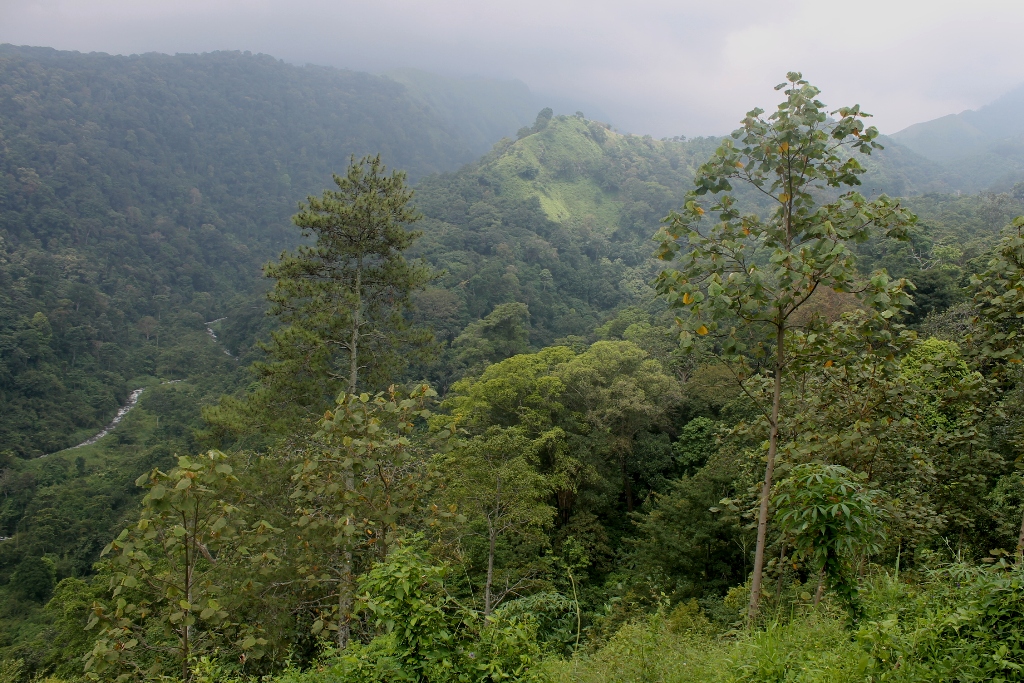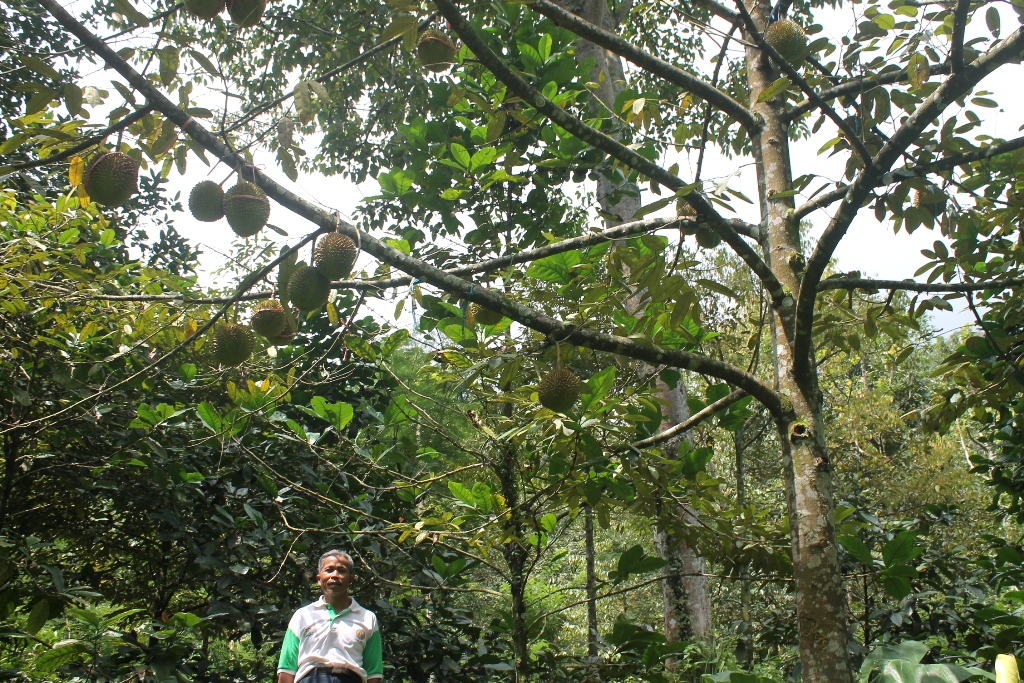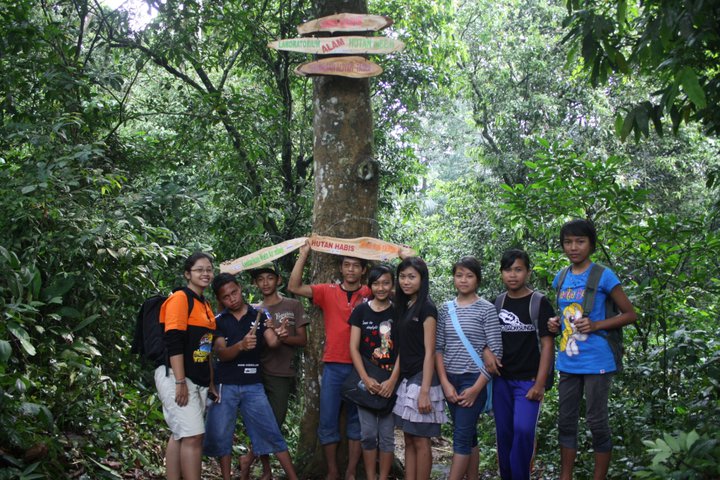- The year following strongman General Suharto’s fall was a period of intense deforestation for Mendiro village in East Java.
- Years later, locals formed an organization to reverse the damage.
- Ten thousand seedlings were planted. The villagers have since been awarded a prestigious conservation prize from the central government.
When the children of Mendiro hamlet would hear the year 1998 in school, chances were it heralded a lesson on Indonesia’s violent lurch to democracy after the devastating financial crash of that year. Almost two decades later the next generation here in East Java is also learning how their parents rebuilt the surrounding forest.
People from the surrounding communities and local police officers razed 50 hectares here between 1998 and 1999, a period that saw intense deforestation during a vacuum after strongman General Suharto fell from power. For years the forests of Java were cut down to fuel demand for timber, pulp and paper as well as to make room for new housing and infrastructure. Only around 5 percent of Java’s original ecosystem remains and many species like the Javan rhinoceros (Rhinoceros sondaicus) are critically endangered. The Javan tiger (Panthera tigris sondaica) was declared extinct in the 1970s.
“In my day there were plenty of durian plants,” Wagisan told Mongabay in Mendiro, around 40 kilometers southwest of Surabaya, Indonesia’s second city.
“Then everything was clear cut, stolen until it was barren.”
Years later Wagisan and 10 others would put their heads together and form the Forest Protection and Water Conservation Association. Kepuh, for short. With Wagisan at its helm, the group applied to the local officials in Jombang regency for support and sought help from the provincial government of East Java, one of 34 Indonesia’s provinces.
“The other residents and I began planting again – jackfruit, hazelnut, dogfruit and many more.”

Day after day members of the community would show up to work – convinced by the merit of Kepuh’s vision – until they had planted 10,000 seedlings from 40 plant species. After the replanting was complete, Kepuh organized a rota to ensure the trees had sufficient water. Frequent patrols were scheduled to guard against would-be loggers.
Public safety was another important part of the replanting program. Fewer tree roots made for less drainage, placing greater stress on topsoil layers and increasing the odds of slippage during periods of heavy rain. The community’s replanting reduced the risks of landslides and flash floods. They even revived a spring that had dried out.
“We did it all alone, with no help from anyone,” Wagisan said.
Tumariono was one of many Mendiro residents happy to take on the responsibilities of a local forest ranger for no pay. Like others, he said the revival of accessible fresh water was incentive enough to work.
“People don’t need pumps here,” he told Mongabay. “The water can be piped directly to people’s houses.”
The social and economic impact of the revived freshwater has been profound.
Prior to the community’s efforts to replant the degraded land, tempers would fray at dried up springs. Violence over water is now a thing of the past.

Greater local control, greater local security
Tensions between communities over local forestry is a common problem in Indonesia, one often enabled by either absent or complicit law enforcement. In 2010, members of a nearby community backed by local police officers cut down 50 pecan trees here. Such opportunism can be a risky endeavor; communities in Indonesia frequently exact violent reprisals on those believed to be guilty of theft. Indonesian newspapers carry stories of a lynching most weeks.
“If anything gets cut down or stolen a crowd will take them to the authorities,” Wagisan said. “If theft is allowed it will be our children and grandchildren who pay the price.”
The 2010 incident was a warning for Wagisan.
“We must not allow forest conservation to become littered with people who are not accountable,” he said. “If the government does not intervene these rules could be broken again.”
Amiruddin Muttaqin, an activist with Ecological Observation and Wetlands Conservation (Ecoton), said the model should be rolled out across the archipelago.
“It should be the case that we have groups like Kepuh in pretty much all our forests,” he told Mongabay. “They have already made things better, properly preserved and maintained and kept the springs alive for the benefit of communities both upstream and down.”
He said the local community are by far the most likely to preserve and maintain forests because doing so aligns with their economic interest. An abandoned 5-10 hectare area in nearby Sigolo-golo should be reforested in the same way, Amiruddin added.
In Mendiro, a handful of foreign tourists visit the hamlet every year, while a trickle of scouting organizations and forestry students witness the ongoing replanting program. The group prepares around 50-100 seedlings every month.
“It’s a jungle now,” Wagisan said. “We have durian, jengkol, avocado, jackfruit, mangosteen and hazelnuts all bearing fruit.”

By the time the durian harvest arrives most of the area is covered in trees bearing the green and gold fruit. Each tree can produce 10-20 fruits, and a family’s plot of land can typically yield 10 trees. One durian goes for 30,000 rupiah (around $2), enabling families to budget for a typical harvest haul of 6 million rupiah – four times the monthly minimum wage in the province. One hundred pecan nuts will fetch 7,000 rupiah, while one walnut tree can grow up to 1,000 nuts.
“You can see for yourself the results of the durian and pecan harvest, not to mention the other fruit trees,” he said. “This community has become more and more prosperous after the successful reforesting program.”
Looking to the future, learning from the past
Mukhlas Bassa backed by the local association of teachers holds special classes for high school students in conservation.
“In 2002 there were major floods in Mojokerto because the land was bare,” he told Mongabay. “In 2007 our worries grew as the forest became more damaged and springs dried up. That really started our effort on the environment.”
At first, however, Mukhlas’s idea to conduct practical classes in the field was more a way of providing something a bit different for a bunch of teenagers at risk of classroom fatigue. But the class evolved to take on practical environmental science lessons.
“We teach plant morphology, conservation, hydrology, river health and nursery techniques, as well as social-environmental entrepreneurs,” he said. “They were unsure at first because many of them are majoring in social studies, not science, but they grew more and more interested.”

Word of Mukhlas’s methods has spread, and children from the provincial capital, Surabaya, and other nearby towns now come to the village to join forest walks and check up on conservation efforts. Muklhas asks his high school students to give presentations to elementary school children, passing on the importance of conservation to children during early years education.
“We took a barren patch of land and gave it an abundance of fruits,” Wagisan said. “We are also protecting wildlife and putting a stop to hunting. Now we’ve started to see monkeys, deer, birds … even a panther.”
Mukhlas believes the results of work by groups like Kepuh offers further evidence of the need to introduce a basic forestry syllabus on the curriculum.
“We hope it’s having a big influence,” he said. “The impact may be that fewer people tear down the forests and out involvement in replanting makes people more conscious and leads them to do start planting trees.”
CITATION:
Petrus Riski. “Belajar Konservasi Hutan dan Mata Air Di Wonosalam.” Mongabay-Indonesia. 30 April 2015.